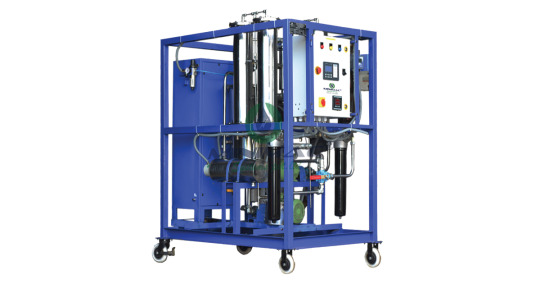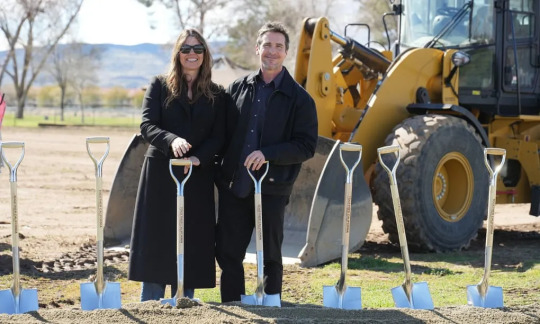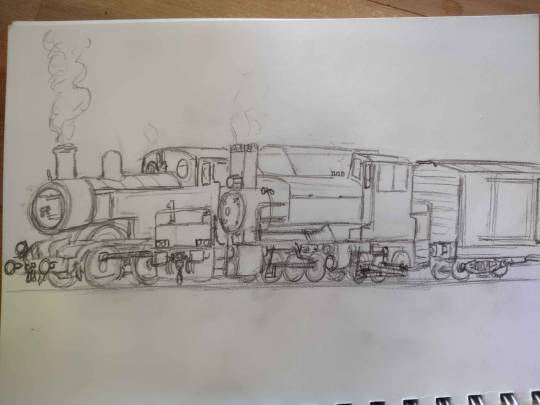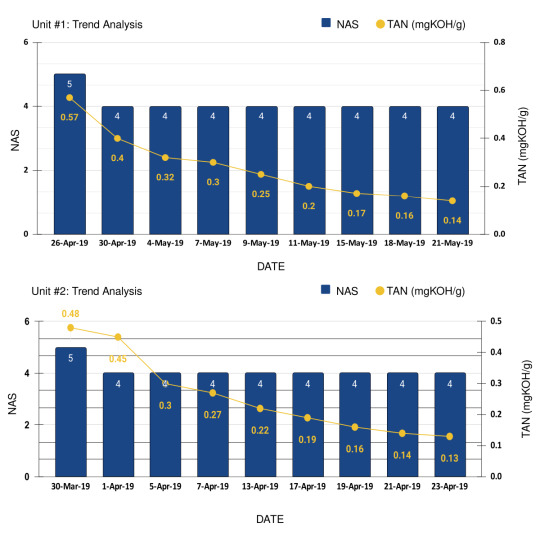#Diesel Conditioning System
Explore tagged Tumblr posts
Text
Reduction of the TAN value of the control fluid from 0.23 to 0.08 mgKOH/gm
Team Minimac successfully executed a critical project to re-condition the control fluid (tank capacity 16 KL) for a 2*600 MW coal-based thermal power plant in Chhattisgarh.
Synopsis
The plant establishes, operates, and maintains a thermal power generating station in Chhattisgarh. There was a problem with higher Total Acid Numbers (TAN), observed typically when moisture content exceeds the permissible range. They were facing difficulties in stable unit operation because of the sluggish and erratic behavior of the turbine governing system. It was a significant threat to generation loss and unit outage. The situation was examined by Minimac Operations and Maintenance Service (MOMS). Three machines - Nitrogen Blanketing TMR unit (100 LPM), Oil purification MLC-LVDH-TRIX (50 LPM), and TAN reduction— Resin filter modified in cartilage format were deployed to address the issue. Oil PurificationTAN ValueNAS ValueMoistureBefore Oil Purification0.23 mg KOH/gm10678 PPMAfter Oil Purification0.07 mg KOH/gm6250 PPM
The major challenge faced during the execution was if we charged resin, TAN will reduce, but moisture would increase. So, an analysis was done and implemented to control the moisture first, then charged the second resin cycle. Minimac gave a 100% customized solution within time.
Problems
The tank capacity was 16k liters, which was huge. The biggest challenge was to execute the project during running operations. Because for moisture control, it was necessary to turn off the system. Water bubbles were forming, leading to the fluctuation in NAS. Resin charge means moisture increase, and our motto was to bring moisture below 500 ppm so we can plan for the next cycle of resin charge.
Client’s Requirement
To purify the control fluid.
To reduce the TAN value from 0.23 to 0.08 mgKOH/gm.
To reduce the moisture levels.
To achieve NAS 6.
Smooth and timely execution without any downtime
Customized solution
No spillage

Solutions
The Nitrogen Generation Unit (TMR) was deployed and installed at the client's site. The salient features of the TMR unit are - 99.9% pure nitrogen, a dew point less than -15 degree celsius, and a dedicated moisture condensing unit.
For Nitrogen Blanketing, TMR – 100 LPM had a flow regulator of 0-150 LPM
Oil purification machine MLC-LVDH-TRIX-50 for NAS & moisture reduction was installed.
Installed 12 new resin filters for TAN reduction in existing recirculation units
Before the oil conditioning process, the TAN >= 0.210 mg KOH/gm (Electronic method) and 0.246 mg KOH/gm (manual titration), which was reduced after oil purification to TAN <= 0.097 mg KOH/gm (Electronic method) and 0.124 mg KOH/gm (manual titration)
For further improvement in TAN, the oil vapor extraction fan(OVEF) was throttled in the range of 50-55%, with the support of the user
They had an LVDH machine, and the NAS standard to be maintained as per the PO was 10+. We gave a better result without the replacement of the NAS filter
Minimac provided trained manpower and other consumables under the MOMS (Minimac Operations and Maintenance Service) offering. Minimac has charged resin in an 8-cycle with 3 hrs intervals. 24hrs resin charge KPI was 0.074 mgKOH/gm.
Cost Saving
This plant managed to save:
Cost of oil replacement: ₹3.2 Cr approx.
Cost of downtime: ₹3.15 Cr approx.
By investing ₹9 lakh only
CO2 e Saving
1,92,000 kg of CO2 e / 0.192 gigagrams of CO2 e
Benefits
Extended in-service oil life.
The smooth functioning of the machines
Elimination of new oil replacement cost.
Avoiding the risk of fire and explosion.
Reduction in the possibility of product degradation due to blanketing

Subscribe to our WhatsApp Community and be a part of our Journey - Click Here
#frf#oil flushing#minimac systems#power#minimac#oil & gas#hydraulic oil#lube oil filter#contamination#hydraulic oil filter#lubeoil#chemcal cleaning#chemical flushing#oil filtration#oil filtration systems#oil purification system#oil purification machine#oil purification#oil dehydration systems#frf condition systems#frf machine#electrostatics lube cleaner#transformer oil cleaning#transformer oil#transformer oil filtration#transformers#coalescer separator#diesel oil purification#mspl#minimacsystems
1 note
·
View note
Text
The Best News of Last Month
Sorry for being not active this month as I had some health problems. I'll start posting weekly now :) Meanwhile here's some good from last month
1. Widow donates $1 billion to medical school, giving free tuition forever

Ruth Gottesman surprised by her late husband's $1 billion in Berkshire stock, decides to donate it in full to the Albert Einstein College of Medicine in the Bronx, New York City's poorest borough. The donation is intended to cover students' tuition indefinitely, ensuring access to medical education for generations.
A video capturing students' emotional reactions to the news, cheering and crying, circulated after the announcement, highlighting the profound impact of the donation on the medical school community.
2. Electric school buses outperform diesel in extreme cold

In Colorado's West Grand School District, electric school buses outperformed their diesel counterparts, particularly in the bitterly cold temperatures of towns like Kremmling, where morning temperatures can drop below -30 degrees Fahrenheit. Despite common concerns about reduced range in extreme weather, the electric buses maintained their battery charge even in these frigid conditions, providing reliable transportation for students.
This success has been welcomed by the school district, as diesel vehicles also face challenges in starting in Colorado's harsh winter weather.
3. Christian Bale unveils plans to build 12 foster homes in California

Christian Bale has led a tour round the new village in California where he plans to build 12 foster homes, as well as two studio flats to help children transition into independent living, and a 7,000 sq ft community centre.
The actor has spearheaded the building of a unique complex of facilities with the aim of keeping siblings in the foster care system together, and ideally under the same roof.
4. Average lifespan of a person with Down syndrome has increased from 25 years in 1983 to 60 years today

Today the average lifespan of a person with Down syndrome is approximately 60 years.
As recently as 1983, the average lifespan of a person with Down syndrome was 25 years. The dramatic increase to 60 years is largely due to the end of the inhumane practice of institutionalizing people with Down syndrome.
5. Greece legalises same-sex marriage

Greece has become the first Christian Orthodox-majority country to legalise same-sex marriage. Same-sex couples will now also be legally allowed to adopt children after Thursday's 176-76 vote in parliament.
Prime Minister Kyriakos Mitsotakis said the new law would "boldly abolish a serious inequality".
6. Massachusetts police K9 tracks scent for over 2 miles to find missing 12-year-old in freezing cold

A Massachusetts police K9 followed her nose to help find a 12-year-old who went missing in frigid temperatures last week, tracking the child’s scent for over two miles, authorities said.
K9 Biza, a female German shepherd, was called on to help after officers learned the child left their home at around 10:30 p.m. Wednesday and was last seen in the Pakachoag Hill area of Auburn, the Auburn Police Department said.
7. Good News for the Socially Anxious: People Like You a Lot More Than You Think They Do, New Research Confirms

The "Lake Wobegon effect" or "illusory superiority" phenomenon highlights people's tendency to overestimate their abilities, but recent research suggests that in social interactions, individuals often underestimate their likability and charm.
Studies indicate that people consistently fail to recognize signals of others' liking toward them, leading to a "liking gap" where individuals believe they are less likable than they actually are.
Techniques such as focusing more on others during conversations and genuinely expressing interest in them can help alleviate social anxiety by shifting the focus away from self-criticism. Ultimately, understanding that others may also experience similar anxieties can lead to a more relaxed and enjoyable social experience.
---
That's it for this week :)
This newsletter will always be free. If you liked this post you can support me with a small kofi donation here:
Buy me a coffee ❤️
Also don’t forget to reblog this post with your friends.
3K notes
·
View notes
Text

NWR No.1 and SLYM No.11513 at a dual gauge interchange just outside of the city center.
SLYM No.11513 is an Advanced Steam Locomotive native to Gymnome--a coal-burning steam engine operating at high pressure, with technological improvements to allow it to rival the efficiency and ease of use of a diesel locomotive, such as electronic controls, compound expansion of steam, a gas producer combustion system firebox, dual exhaust, and automatic firing and oiling. 11513 was built some time in the 2340s, and survives to 2381 as a museum piece.
NWR No.1 is a much older locomotive and from another planet altogether, built 1915 for the LBSC railway as a one-off prototype for a six-coupled shunter to replace the aging Terriers and to supplement the much larger E2-tanks. NWR No.1 made it to the North Western Railway not long after it was built, having been allocated there for the war effort. It is not clear how a locomotive built 465 years in the past on planet Earth made it intact to Gymnome, nor how its gauge perfectly matched Goo'iw Broad Gauge, at least not without invoking some kind of universe-spanning magic railroad, or perhaps the notion that this is all a simulation being run in some kind of virtual reality in some alien starship.
(no this isn't canon.)
Artist's notes:
Earlier today I doodled this in my sketchbook.

And when I got home i decided, hey, I have my Thomas 3D model, and I have the game model of the Advanced Steam Tank Engine... why not actually stage them together and draw them to-scale. The size difference is greater than I expected--partly I think this is because the Thomas gauge-1 prop was not designed with scale in mind, so it's bigger than British Railways loading gauge. Granted, they are at different gauges (standard gauge versus roughly meter-ish gauge), but the loading gauge on the advanced steam engine is very wide.
My first attempt at the drawing was from a very different angle:

But I quickly realized that you can't actually see the Advanced Steam Engine's wheels, and that's a major design aspect.

So i chose a different angle.


I constructed the dual gauge track before anything else.

And before long (the better part of 2 hours) I had the line art finished.
The Advanced Steam Engine ended up being a hybrid between the original illustration I did of it months ago, and the game model--with most of the geometry accurate to the game model, but with the subtler detailing of the illustrated version.
Thomas was meant to be a sort of hybrid of the Gauge 1 Prop from the TV series and a realistic loco. I prioritized the geometry and simplicity of the gauge 1 prop in most respects, but added details below the running board, in particular brake rigging, sanding gear, and these blade-like protrusions of the frames which i'm pretty sure are some kind of debris deflector, a british version of a cowcatcher. There's also snifters on the cylinder saddle, and the whistle is made of two different lengths to justify Thomas' multi-tone whistle.

The original background was going to be this marshland with (electricity-generating) windmills in the background, a callback to that first shot in the Thomas & Friends opening credits, but I hated how it felt like the middle of nowhere, so I introduced the retaining wall and an alien city scene.

British steam engines are generally given very shiny liveries which reflect the environment in interesting ways, so I made sure to do that justice, using a GWR 14xx autotank as reference.

By contrast, the Advanced Steam Tank Engine is kept in a more workwormlike condition, with a somewhat faded matte paint work and a fair amount of grime.

The original illustration of the advanced steam engine, for comparison.

Finally, a version with faces.
#advanced steam engine#tank engine#thomas the tank engine#ttte#train puzzle#mellanoid slime worldbuilding#train#steam train#ttte thomas#steam locomotive#worldbuilding#art#digital art#crossover
184 notes
·
View notes
Text
The flotsam and jetsam of our digital queries and transactions, the flurry of electrons flitting about, warm the medium of air. Heat is the waste product of computation, and if left unchecked, it becomes a foil to the workings of digital civilization. Heat must therefore be relentlessly abated to keep the engine of the digital thrumming in a constant state, 24 hours a day, every day. To quell this thermodynamic threat, data centers overwhelmingly rely on air conditioning, a mechanical process that refrigerates the gaseous medium of air, so that it can displace or lift perilous heat away from computers. Today, power-hungry computer room air conditioners (CRACs) or computer room air handlers (CRAHs) are staples of even the most advanced data centers. In North America, most data centers draw power from “dirty” electricity grids, especially in Virginia’s “data center alley,” the site of 70 percent of the world’s internet traffic in 2019. To cool, the Cloud burns carbon, what Jeffrey Moro calls an “elemental irony.” In most data centers today, cooling accounts for greater than 40 percent of electricity usage.
[...]
The Cloud now has a greater carbon footprint than the airline industry. A single data center can consume the equivalent electricity of 50,000 homes. At 200 terawatt hours (TWh) annually, data centers collectively devour more energy than some nation-states. Today, the electricity utilized by data centers accounts for 0.3 percent of overall carbon emissions, and if we extend our accounting to include networked devices like laptops, smartphones, and tablets, the total shifts to 2 percent of global carbon emissions. Why so much energy? Beyond cooling, the energy requirements of data centers are vast. To meet the pledge to customers that their data and cloud services will be available anytime, anywhere, data centers are designed to be hyper-redundant: If one system fails, another is ready to take its place at a moment’s notice, to prevent a disruption in user experiences. Like Tom’s air conditioners idling in a low-power state, ready to rev up when things get too hot, the data center is a Russian doll of redundancies: redundant power systems like diesel generators, redundant servers ready to take over computational processes should others become unexpectedly unavailable, and so forth. In some cases, only 6 to 12 percent of energy consumed is devoted to active computational processes. The remainder is allocated to cooling and maintaining chains upon chains of redundant fail-safes to prevent costly downtime.
520 notes
·
View notes
Photo

U-Boat: Germany's Submarines of WWI & WWII
The U-boat, short for Unterseeboot (undersea boat), was the name for submarines used by the German Navy during the First World War (1914-18) and Second World War (1939-45). In the two Battles of the Atlantic, U-boats sank thousands of ships, but defensive strategies such as dropping depth charges, providing air cover, and, above all, the convoy system, ensured Britain was supplied with the resources it needed to continue both wars until victory was achieved on land.
U-Boats in WWI
When WWI began in 1914, the German Imperial Navy had only 20 operational submarines or Unterseeboots (undersea boats), as they were known, a name soon shortened to U-boat. Together, Britain and France had around 200 submarines. German production went into overdrive to catch up. The German navy constructed several classes of submarines to meet different requirements, such as coastal patrols, laying mines, and long-distance vessels. By 1917, Germany had 140 U-boats. While the British Admiralty focused on smaller submarines for the defence of ports, Germany opted for a vessel that could attack enemy shipping anywhere at sea. U-boats became particularly important following the Battle of Jutland in May 1916 (a strategic victory for the Royal Navy, but one with high losses), after which the giant German battleships were largely confined to port. U-boats, on the other hand, were free to roam hidden beneath the waves and attack at will any enemy target they came across in the North Sea, Atlantic Ocean, and the coastal waters of the British Isles.
The earliest U-boats, the UB class, were limited to coastal operations, but developments improved their operational capacity as the war wore on. The typical WWI U-boat had a range capable of reaching the Western Atlantic Ocean, a top speed of 17 knots, and displaced around 700 tons. U-boats carried six torpedoes. Two torpedoes could be fired from the bow and two from the stern. The submarine also had a gun which could be fired when on the surface; this had a minimum calibre of 4.1 inches (10.4 mm). A diesel engine was used when on the surface, and twin electric engines when submerged. The crew on board numbered up to 39 persons. Conditions on board were extremely cramped and uncomfortable, and made worse by the constant stench of diesel fuel, which even permeated the taste of the submariner's food.
The German Navy built a larger class of U-boats, which was unarmed but capable of carrying cargo. The Deutschland was the first of this type, put in service in 1916. Some of these cargo submarines were subsequently converted into armed vessels known as U-cruisers, although the first were not operational until 1918. The U-cruisers had an impressive range of 12,000 nautical miles, and they could well have turned the tide of the war if they had been produced earlier and in larger numbers.
The UC-class submarines were used as minelayers from 1915. With a slow speed of six knots and a limited range of 750 nautical miles, these vessels were designed to stay near coastlines and lay mines, 12 per trip. The mines were released from near-vertical tubes that had been flooded. An upgrade to the class in 1916 increased the range tenfold and the mine load to 18. The UC II class was also armed with a 3.4-inch (8.8 cm) gun. The UE-class submarine was a larger, ocean-going version of the UC-class. The UE-boats, in service from 1915, could voyage 8,000 nautical miles and carry 34 mines. A class upgrade in 1918 meant the newer UE-boats could carry 42 mines in their tubes and another 30 in deck containers.
Read More
⇒ U-Boat: Germany's Submarines of WWI & WWII
58 notes
·
View notes
Text
A Starlight Express LARP game would be a nightmare because you are combining roller derby AND trains and will have rules approaching “nuclear power plant regulations” tier
steam engines have massive, massive physical limits and have to wait around a lot to warm up/cool down, refuel, be maintained. The big sort-of pro: Explosion. You can just take out everything and everything if threatened.
electric trains are hilariously OP but have the most exhausting rules and pages and pages and pages of infrastructure lore, physical constraints, and depending on regional conditions, roll for catenaries icing/sagging/snapping in the wrong weather. You have to keep at least one skate on a taped line representing a sort of third rail.
diesel trains are the reasonable option. Relatively average ability-wise, but doesn’t involve scouring the TOMES to determine how to deal with your specific questionable electrification system or all the waiting of steam engines.
unpowered cars would be like roller derby blockers probably. I don’t even know what trains on roller skates LARP would involve
#Stex#starlight express#I’m sure electric mode is more reasonable in germany or somewhere but us/uk would be hysterical#fixed attachment catenaries that will take you out if it’s too hot or having to constantly play limbo undet Victorian bridges
29 notes
·
View notes
Text
From one of my Danish friends who works for an NGO in Gaza:
HUMANITARIAN ORGANIZATIONS LIE ABOUT THE HUMANITARIAN SITUATION IN GAZA
Every single day we hear from various humanitarian organizations that the situation in Gaza is catastrophic and that there is now only fuel, water or medicine for a day before the famous one diesel generator in Gaza stops, the lights go out and the sick can be treated due to a lack of medicines.
It must be remembered that these organizations have an interest in exaggerating and dramatizing the situation - to put it nicely. In fact, they often lie, and they must know that themselves, because they have their own representatives on site. One must also remember that there is no independent media in Gaza that could check the many exaggerations and lies. Hamas strictly controls what is published, and it is dangerous to question or correct Hamas' censors.
The Israeli defense has a special unit that deals professionally with the humanitarian situation in Gaza. The unit regularly receives information from international organizations that are represented in Gaza, and also builds on knowledge that is generally available. From this we see a more realistic picture of the conditions than what the humanitarian organizations provide:
There is NO shortage of food in Gaza, but sufficient stocks for several weeks' needs. As far as drinking water is concerned, Gaza is 90% self-sufficient. Only 10% comes from Israel through 3 water supply pipes. Israel has recently opened 2 more supply lines.
Hamas has full control over the distribution of medicine and hospital equipment and decides how much the hospitals will receive and when. (Hamas probably needs these things themselves now that they are suffering daily heavy losses given the targeted Israeli attacks on the terrorist organization's numerous military facilities)
Hamas' many rocket attacks against Israel, which continue, have destroyed several of their own electrical lines that supply electricity to Gaza from Israel - moreover, on a larger scale than the generator the media keeps talking about.
All hospitals in Gaza have their own solar powered electrical systems to supplement diesel generators. Other generators scattered across Gaza territory are controlled by Hamas, which also stores large quantities of diesel oil in the underground tunnels. Three weeks have passed since the hospital administrations in Gaza declared that they only had diesel fuel for the next 24 hours. But the hospitals continue to function because Hamas supplies them with fuel.
Hamas is interested in the hospitals functioning because Hamas has their military headquarters inside and under the hospitals, which they have thereby made part of the military infrastructure.
Red Cross employees in the Gaza Strip are from the Red Crescent, they are Palestinians, they protect Hamas. Their monthly salary comes from the organization.
The Red Cross in Denmark, for example, does not talk about the 239 Israeli hostages to which the Red Cross has not had access.
According to international rules/laws, the Red Cross must have access to the hostages, some of whom are babies and small children, others are young and elderly. The Red Cross does not talk about the lack of supervision of the Israeli hostages in the Gaza Strip.
Wonder why?
#secular-jew#israel#jewish#judaism#israeli#jerusalem#diaspora#secular jew#secularjew#islam#antisemitism#judea#tel aviv#islamism#samaria#vieformidable#Hamas#Gaza#disinformation#lies#misinformation
456 notes
·
View notes
Note
I work as an auto shop receptionist. Not even a big, like, chain company (like Jiffy Lube or the like), just a little shop that you'd drive past and not even realize it's there unless you were looking. And we get some of the most entitled customers, I swear. To list a couple of the most memorable ones:
1) A customer's vehicle totaled out by his insurance company. They would not pay for the repairs. The vehicle was in absolutely no condition to be driven (missing the whole front end, front axle busted, etc). The customer showed up at the shop, demanding his vehicle back, demanding to know why we weren't fixing it, and then called the cops on us when we would not just give the vehicle over without him paying checkout costs. He was complaining about needing his car back to drive Uber. My guy, you are not driving Uber in that piece of shit. Even the cop looked at the guy like "this isn't a 911 emergency, stop wasting our time".
2) A customer was told her vehicle would be done on XX date by our automated system. We explain, in great detail throughout communications, that the automated system is not a guaranteed date, but an estimated date that can fluctuate based on any number of variables (deliveries get delayed, wrong part comes in, additional damage gets found, insurance company twiddling their thumbs), and as a rule we cannot release a vehicle to a customer without some form of proof of payment. From insurance companies we get a pay screen (a screenshot showing payment is being issued) that gives us the okay. Well, she shows up at our shop on XX date...vehicle not only is not done, but we also don't have the payscreen. She proceeds to flip out like the raging Karen she is (she even had the haircut) and said we were "holding her car hostage". No amount of explaining that the vehicle was not fucking done yet would appease her, not even from the manager. When she came back when the car WAS done, she was unbelievably bitchy about it.
3) A customer who apparently thought he could just leave a completed vehicle on our lot for over a month and that storage charges were just a bluff. Needless to say, he got particularly irate when he came in and had nearly $2000 in storage on top of the cost of repairs because we called him and left him more messages than I can count warning him "hey, pick your shit up, you're accruing storage". Every vehicle that just sits here means one less spot for a vehicle we can work on.
4) A lady called our shop bitching about us not diagnosing her car properly. She neglected to tell us that her car was a diesel engine, and our system is not calibrated for diesel engines, so it would need to be taken up to a dealership for them to calibrate and we'd sublet the bill. She AND her dad then proceed to harass not only us but the dealership every hour, every day, demanding to know when her vehicle was going to be looked at. It got so bad the manager at the dealership called us like "you need to tell this bitch to chill".
5) Lady brings in a van that was damaged because a mouse got into the vehicle and chewed the hell out of the seats. We cannot get replacement seats (vehicle's like a 2011-2012, with specific colored seats, and they just plain don't make that shit anymore), so we arrange to get the existing seats reupholstered since the vehicle is getting detailed. She proceeds to call screaming "I DON'T WANT THEM REUPHOLSTERED I WANT NEW SEATS WHAT IF THEY STINK". Can't fucking win.
Posted by admin Rodney
66 notes
·
View notes
Text







On March 3rd 1883 three hundred inhabitants of the remote Shetland island of Foula were on the point of starvation as the first supply boat of the year reached the stormbound community.
Foula, often described as the "Edge Of The World" is our most remote inhabited island. It is situated in the Atlantic Ocean approximately 20 miles to the west of the Shetland mainland. It is an island of crofting townships, breath-taking sheer cliff drops, and a wealth of wild flowers and wildlife.
Over a century ago, in 1881, Foula had a population of 267, mostly employed in fishing...at the last census in 2001 that figure had dropped to just 38.
On March 3rd 1883 the Shetland Times published this;
The Weather and Mails – Foula
Nine weeks have now expired since our last mail was landed, and all our resources are almost exhausted. Sugar and tobacco have been all done for more than a fortnight, and tea, coffee, etc, are now done also. Those who had a little meal to spare have helped those who had none, a thing often done in Foula, but if the weather does not moderate we will soon be all alike. The boat has been in readiness now for some time to go to Walls for supplies, and as the weather has become a little more moderate today they are going to make a start, so we hope that they may get safe through, and a chance to return again soon. But we doubt if the mail boat will be able to cross today yet, as the wind still inclines to the westward.
There isn’t much more than this about their plight, but it seems that same day they breathed a sigh of relief as a boat must have made it to Mainland and back successfully.
Today crofting as well as fishing are the main activities, half the population living at Hametoun in the south east and the remainder to be found at Ham near Ham Voe on the east coast. The island is not connected to any mainland electricity grid system. In 1987 a community electricity scheme was constructed, comprising a 3.3kV island grid which linked diesel generators, a wind turbine and a hydroelectricity scheme to the island’s properties. This scheme gradually fell into disrepair and has undergone a major refurbishment, funded primarily through grants.
Before refurbishment, the entire island's power was supplied by one of the two diesel generators which operated between approximately 7.20am and 00.30am. That’s not to say they were without power for the, just under 7 hours the generator is off, a battery/inverter system was installed between 2006 and January 2007, a solar charging array helps top up the batteries as well . The system was fully commissioned at the beginning of March 2007 and already the islanders not only have continuous power ( instead of the previous 17 hours per day) but are noticing considerable savings in diesel fuel use. Since diesel has to be shipped in by ferry (and often the weather is too bad for the ferry to run for up to 3 weeks on end) this of huge value.
An interesting feature of the island's people is that they still observe the old Julian calendar, replaced in 1752 in Britain by the present Gregorian system which deleted 11 days from the year. Remote areas of the country kept to the old calendar, adding an extra day in 1800, which was a leap year, and some parts of Shetland continued to observe festivals 12 days after the dates in the new calendar. The most remote areas kept to the old calendar longest, and the people of Foula still celebrate Christmas on 6 January and New Year's Day on 13 January
Travel to the island is by sea or air and is completely dependent on suitable weather conditions.
A wee bit more, and a short video can be found at the link below.
48 notes
·
View notes
Video
I’m working on my first long Good Omens inspired fan fic (Human AU). Crowley and Aziraphale are both long distance sailors getting ready to compete in a singlehanded, round the world race. In an effort to keep going and be accountable, I’ve posted a proposed snippet--unedited, first draft. Let me know in the comments if it makes you want to see more. Tagging a few writers whose works have inspired me to do something so stupid brave. (@holycatsandrabbits, @pookasluagh, @klikandtuna, @missunderstoodlyrics, @bellisima-writes, @waitingtobebroken, @itsscottiesstark, @dragonfire42, @lavendermoonlitskies, @di-42) Still handling smoothly, the car gave no hint of strain as the speedometer hit 160 kph—why can’t Americans join the rest of the world? I mean it’s not like there’s any logic to it. They fuck off because they can’t stand British rule just to hang onto this archaic system of measurement, I mean… Crowley took a deep breath and banished his brain imps before he couldn’t find his way back. Because he had been thinking something. Now what was it? Oh. Yeah. He was boooooooooored. Transcendentally bored. If he could set his alarm and not wake up until Beaufort… Well, technically, he could have flown. But it wasn’t just about speed, was it? It was about reading the conditions, outwitting nature, and controlling—well, something. Crowley was too smart to think he was in control of anything. Not really. But even smart people paddle that river in Egypt. Nope. Driving, even at these speeds, offered none of the thrills of helming a sailboat on the open ocean with spray pouring over the bow. Shouting to your crew over the roar of the sea. Or outwitting your competition when you sensed a shift in the wind before anyone else. He’d rather be rail meat for some twatwaffle captain in a bumfuck village regatta in the South Downs than be reduced to only driving a car the rest of his life. Not that it would ever happen. He was the best in the world—or at least, that’s what he intended to prove. But if you’re going to go, might as well do it with style. He patted the steering wheel of the sports car affectionately before slowing slightly to take his exit—Beaufort. He loved a thrill. He wasn’t crazy. ****************** Yanking the line from the clutch, the man rushed to the bow, avoiding the flogging mainsail. He dropped the anchor and waited for it to stop the boat's motion as it grabbed the muddy bottom. In what seemed like only moments later, the anchor had set and the fair-haired figure congratulated himself on a job well done. He could have used the diesel engine to anchor. But there’s a satisfaction that comes with doing things the way sailors have done them for centuries. And one must not let one’s skills decline. Why call yourself a sailor if you rely on an engine for every tricky maneuver? And, after all, Aziraphale had standards. It just wouldn’t do for him to do what most sailors would do. He was the best in the world—or at least, that’s what he intended to prove. Again.
32 notes
·
View notes
Text
PE fluid reconditioning in turbine EHC system
A 1,320 MW (2 x 660 MW), one of the first and largest supercritical coal-fired power plants using Indo-Chinese turbine EHC system in northern India
Synopsis
The plant was struggling with the rapid increase in TAN values in the EH oil of the governing system of the turbine. Moisture content was also more than permissible limits. Degradation of the oil was due to contamination ingression into the system resulting in by-product formation.

Problems
Degradation of EH oil properties at both the units of the plant.
The installed regeneration system for each EHGC tank of unit #1 and #2 was failing to control neutralization number (TAN value) and showing a rapid increase in the same
The company was unaware of the consequences of increased TAN values like possibilities of failure of servo valve, hunting, power generation loss, unplanned shutdown, etc
Solutions
Installation of Minimac’s EH oil reconditioning system “MLC LVDH TRIX 20” comprehensively designed with 4 major technologies to:
Remove solid contamination from oil by Superfine filtration
Remove moisture from oil by vacuum Dehydration technology
Reduce Total Acid Number (TAN) by Ion exchange technique.
EHC system tank moisture removal and ingress prevention by Inert Gas blanketing technique.
Along with equipment installation, our service engineer trained the customer’s team on the functions of the EH oil re-conditioner, FRF maintenance, contamination control, and importance of the oil analysis program.
Cost Saving
This plant managed to save:
Cost of oil replacement: ₹78 Lakh approx.
Cost of downtime: ₹5.6 Cr approx
CO2 e Saving
14,400 kg of CO2 e / 0.0144 gigagrams of CO2 e.
Benefits
Extending oil life.
Eliminate oil Replacement cost.
Protect Turbine against hunting.
Increased Turbine reliability.

Subscribe to our Whats App Community and be a part of our Journey - Click Here
#frf#oil flushing#minimac systems#power#minimac#oil & gas#hydraulic oil#lube oil filter#contamination#hydraulic oil filter#lube oil flushing#coalescer separator#oil dehydration systems#lvdh full form#mlc lvdh#transformer oil filtration#turbine oilanalysis maintenance lubrication reliability contaminationcontrol oil powerplants oilfiltration rotatingequipment mechanical bre#oil filtration#oil filtration system#oil filteration#oil filtration machine#oil filtration systems#oil contamination#frf condition systems#diesel oil purification#hydraulic oil cleaning#chemical cleaning
0 notes
Text

Subaru Bighorn Irmscher. A rebadged Isuzu Trooper Irmscher.
SUBARU BIGHORN irmscher
2800 TURBO DIESEL
The individuality of this 4WD is quite different from passenger 4WDs, with specs tuned up through technical collaboration with Subaru Bighorn Irmscher and Nishi Irmscher, turbo diesel power that leaves no room for rivals, an intelligent body, high-quality equipment from RECARO, MOMO, MICHELIN, etc., and reinforced gas shock mounts that are well versed on the autobahn. The wild potential has been refined with a sense of the city. This is a European high-performance 4WD.
European high performance 4WD. Subaru Bighorn Irmscher
115ps/Intercooler turbo diesel
The flagship engine of the Ilm chassis series. A direct-injection 2771cc turbo diesel fitted with an air-to-air intercooler, it produces a maximum output of 115PS/3,600rpm (net), while also achieving the persistent torque and super response required at low speeds off-road.
Irmscher Tuned Suspension The suspension, tuned by Irmscher of West Germany, is a double wishbone type at the front and a highly durable leaf spring type at the rear. The suspension, thoroughly forged in Europe, gives the car the ability to easily handle both on- and off-road conditions. The tires are made by Michelin and the car is fitted with forged 3-piece aluminum wheels ((IRMSCHER-R)).
Center through drive 4WD with excellent driving balance. The transfer case is an integrated transmission with a center through life system that provides excellent power transmission. Approach angle: 43, departure angle: 33, maximum stable lean angle: 45 left and right, it boasts outstanding off-road driving ability.
West German Recaro seats and Italian MOMO steering wheel. Super equipment that further enhances the bold expression of the European silhouette. The seats are Recaro, a famous sports seat made in Germany, and the steering wheel with built-in heater is made of high-quality leather by MOMO. In addition, various equipment such as power steering and cassette stereo are also available.
20 notes
·
View notes
Text
If you believe the news, these days, it's never been easier to get murdered. Everyone is waiting to snuff you out. Even suburbs are roiling apocalyptic zones that mandate you buy a very expensive security system and an up-armoured luxury SUV. A road trip is completely out of the question. After all, who knows what kind of whackos are out there?
To answer this question, we became those whackos. No, we didn't serial kill, or even parallel kill anyone. What we did was load up the old '72 Toyota Crown wagon with a bunch of spare oil and parts and hit the road. We wanted to figure out if the world really was all that dangerous, and to prove it, we stayed at only the sketchiest bed and breakfasts across New England.
Things got off to a bad start. You see, the coterie of folks that I usually travel with are not exactly the most refined individuals. Because a lot of us were raised entirely by junkyards and our parents' respective parole officers (thanks Joerg) we have trouble "fitting into" the conventional structure of society. That wouldn't stop a serial killer, of course, who would surely prey on at least one of our group as we slept soundly inside Maryland's least rat-infested rustic cabin.
No such luck. In fact, it turns out that the proprietors were afraid of us. They had been conditioned by the news, you see, and spent the entire night sleeping in shifts, wondering when we would burst through their bedroom door, looking for jewelry that we could hock for money to afford a Holley carburetor rebuild kit. Little did they know that the Crown was in fact running a diesel engine out of a Cuban grey-market lawn tractor, and also that we had no intention of ruining the experiment by trying to cause trouble.
That first morning, we parted, each group wary of the other. The experiment could not continue: it was likely that we would encounter the same problem the entire way up the Old Bay Expressway. We knew what had to happen next. After driving at high speed, we arrived at the local TV station, barely shaven and ready to pitch our new fear-based "action news" program. The audience would surely believe ridiculous lies coming from disgusting dirtbags like ourselves, our crude language and 10w40-stained visages lending our dire warnings extra authenticity.
"Folks," I began, in my most folksy voice, "you gotta get rid of any old Mopar parts you have on your property. They were made by sleeper-agent Communist agitators working with the Y2K bug. Send them to me for destruction."
222 notes
·
View notes
Text
Roman Abramovich's $600 million Eclipse superyacht is so massive that it is burning one ton of diesel every day to run its air-conditioning, just so that sea water and mold do not spoil its plush interiors and expensive artwork and keep its anti-paparazzi laser system running.
https://luxurylaunches.com/transport/roman-abramovich-eclipse-superyacht-air-conditioning-25012025.php
#Roman Abramovich#superyacht#yacht charter#yacht rock#luxury yacht#lil yachty#yacht#industrial pollution#air pollution#pollution#pollutants#polluted air#polluted water#ausgov#politas#auspol#tasgov#taspol#australia#fuck neoliberals#neoliberal capitalism#anthony albanese#albanese government#eat the rich#eat the fucking rich#eat the 1%#class war#environmental protection agency#environmental protection#environmental activism
8 notes
·
View notes
Text
Brazil's farmers bet on solar energy and batteries to stabilize power supply

Brazilian farmers have been expanding their solar energy capacity and testing batteries as a storage solution, in a bid to make electricity supplies more predictable and potentially reduce diesel consumption, according to growers and experts.
Increased use of alternative energy in Brazil, the world's largest exporter of various food staples, means greater business for equipment providers, reduced dependence on fossil fuels, and more efficient farming.
Companies that provide energy solutions, such as WEG (WEGE3.SA), say that farmers' interest in battery-based storage systems has risen in recent months, with projects coming into fruition after a sharp drop in battery prices.
Rural properties currently account for approximately 14% of all installed solar power in Brazil, with 4.8 gigawatts distributed via small photovoltaic stations, often built on rooftops or unused land. Solar capacity in agriculture has grown more than seven-fold since 2020, when renewable-source projects took off across the country, according to a survey by the Brazilian Association of Photovoltaic Solar Energy. The association said the number of rural consumer units using solar panels had jumped to 471,000 by the end of 2024, from 54,000 four years earlier. Brazilian farmers use solar power for crop irrigation, air conditioning systems, lighting, pumping water into reservoirs and powering cold storage rooms.
Continue reading.
3 notes
·
View notes
Text
wacky train society thoughts: virtually NO all-electric trains claim diesel-electrics as “electric trains”. That is a very one way street where only diesel electrics claim to count as “electric”, it’s like how “Judeo-Christian” is 99% used by the latter vs the former. Yes, larger diesel locomotives became practical in the 20s-30s when they started using electric transmission technology from existing electric locos…. but they’re WILDLY different politically and economically (and culturally) because depending on external electrical infrastructure for power vs an onboard generator totally changes where and how you live. Whether you care about the condition of the power grid and catenary tension or emissions laws and compression ratio is a HUGE divide.
There’s a whole spectrum of assimilation and blending with bimodes, who are somewhere in between and open about that. Some are mainly electric with some diesel backup, some are just diesel-electric with a third rail shoe for puttering around tunnels. Of course anyone can be converted to one or the other with enough effort and is pretty much instantly accepted because cultural divides between traction is based on very utilitarian things.
Battery trains are allowed the electric label since technically they did have it first, but they’re not culturally or politically the same as non-battery electric.
hilariously enough, electric trains DO claim electric models as their own because they more or less run like tiny versions of full-sized third rail (and two-rail systems were used once or twice on early tramways). The very first electric train was technically model-sized (Thomas Davenport’s in 1834) and their early history had a lot of fine lines between “oversized toy” “really tiny freight railway” and “we’ll count this as light rail”. I think they see them like fairies.
#stex#starlight express#i think it’s funny how widespread this is in various spheres. it is SUCH a one-way claim#I have absurd takes on how dieselism is technically heresy to electric trains and the long history of their cultural/religious influence#all the various -electric types are varying degrees of heretical but they just look at them sadly and go “it’s not too late to come back”#US-based diesel-electric mainly see orthodox electric train religion as an obsolete relic they evolved past the need for#but that is a US/otherwise unelectrified region thing and NOT global at all#(Steam engines are a totally seperate cultural group as electric trains developed seperately early on)
8 notes
·
View notes